Of the 6,776 home runs hit in 2019, the longest was this 505-foot bomb hit by Nomar Mazara off his new teammate Reynaldo Lopez.
https://gfycat.com/timelygrossgermanspaniel-baseball
While this power display likely told Lopez all he needed to know about Mazara, the rest of Chicago’s South Side probably has some questions about the new outfielder. Questions like: “You were such a touted prospect, what happened? After four seasons in the majors, why do you only have 79 home runs? Aren’t you just a strong-side platoon hitter? How are you going to help the White Sox?” All are legitimate (but cruel) to ask.
White Sox fans would be well within their collective rights to call up Mazara’s career stats:
| G | AB | PA | HR | R | RBI | SB | AVG | OBP | SLG | BB% | K% | wRC+ | |
|---|---|---|---|---|---|---|---|---|---|---|---|---|---|
| 2016 | 145 | 516 | 568 | 20 | 59 | 64 | 0 | .266 | .320 | .419 | 6.9% | 19.7% | 91 |
| 2017 | 148 | 554 | 616 | 20 | 64 | 101 | 2 | .253 | .323 | .422 | 8.9% | 20.6% | 87 |
| 2018 | 128 | 489 | 536 | 20 | 61 | 77 | 1 | .258 | .317 | .436 | 7.5% | 21.6% | 95 |
| 2019 | 116 | 429 | 469 | 19 | 69 | 66 | 4 | .268 | .318 | .469 | 6.0% | 23.0% | 94 |
| Totals | 537 | 1988 | 2189 | 79 | 253 | 308 | 7 | .261 | .320 | .435 | 7.4% | 21.2% | 92 |
This is about as average as production gets. Is Mazara just a below-average wRC+, 20 home run, 130 R+RBI, .260 hitter?
Let’s try to find out.
Batted Ball Profile
Before casting aside Mazara’s 2019 as a disappointment, there are a couple of things to note: One, Mazara posted the highest batting average of his career; and two, his typical seasonal production came in a career-low 116 games and just 429 at-bats.
As a left-handed batter, Mazara hasn’t been a heavy target for defensive shifting. His all-fields approach has improved season-to-season:
| Pull% | Cent% | Oppo% | |
|---|---|---|---|
| 2016 | 34.9% | 38.6% | 26.5% |
| 2017 | 29.0% | 46.2% | 24.7% |
| 2018 | 34.4% | 35.2% | 30.5% |
| 2019 | 32.3% | 36.5% | 31.3% |
| Totals | 32.8% | 38.8% | 28.5% |
His 2019 home runs (black dots) show a nice spray throughout the field with eight left of center and 11 to the right of center. His ground balls (green dots), however, show a much easier to exploit concentration of balls hit between first and second.
He was shifted against 41.8% of the time in 2019 (195 of 467 plate appearances), and the shifts actually helped Mazara. According to Statcast, he hit for a .343 wOBA when shifted against and a .315 without. Here is how he was shifted against with the bases empty in 2019 (green dots are ground balls):
Mazara’s batted balls showed marked improvement in 2019. Keeping in mind that he had the fewest at-bats of his career, he set a career-high in barrels and posted his highest wOBA, xWOBACON, xSLG, xBA. Of the 250 qualified hitters this season, his 10.7% barrel rate (barrels/batted ball event) ranked 65th and his 7.5 barrels/PA ranked 46th. His max exit velocity was 114.6 mph (32nd highest) and his average exit velocity was 89.1 mph, good enough for 124th.
Mazara made a huge improvement in handling off-speed pitches.
| # Thrown | HR | BBE | BA | xBA | SLG | xSLG | WOBA | xWOBA | Whiff % | |
|---|---|---|---|---|---|---|---|---|---|---|
| 2018 | 297 | 2 | 54 | .233 | .262 | .433 | .439 | .323 | .339 | 27.9% |
| 2019 | 227 | 5 | 55 | .387 | .358 | .710 | .626 | .472 | .421 | 22.7% |
In a Sept. 3 article in the Fort Worth Star-Telegram, Mazara described that he needed “a better understanding of how pitchers are attacking him … the league changed its approach to the whole lineup, trying to take advantage of the hitters’ aggressiveness. Pitchers stopped throwing fastballs in hitter’s counts, and the Rangers were hacking at off-speed pitches that either weren’t strikes or couldn’t be driven.”
Mazara has obviously made an adjustment to off-speed pitches, and the hope is that he can carry this forward into 2020. If he can continue to demolish off-speed stuff, pitchers will have to come back to him with fastballs. With the right approach and preparation, he should be able to pounce on those pitches and hit them with authority.
We know that there is potential: Mazara has shown the ability to hit the ball hard. The problem is that his overall results have, to this point, been decidedly average. Let’s try to understand why.
Zone Charts
Statcast zone charts are a fascinating look at Mazara in 2019. Of the 44 zone charts displayed, there are two clear problem spots: the bottom and middle of the zone (zone 8), and pitches down and outside (zone 13). Let’s examine this a little more closely with some help from Pitcher List’s Nick Kollauf:
We instantly see some of Mazara’s shortcomings. His ground ball rate in Zone 8 and 13 are ridiculously high against both lefties and righties. He struggles to elevate the ball in both zones with a paltry line drive rate and minuscule fly ball rate. As a left-handed hitter, Mazara struggles to get good wood on pitches low and outside, but Zone 8? That’s middle-low! He needs to make better contact there. Here is the contact he did make:
Ugh. In every ratio category, Mazara’s in-zone results were lowest in Zone 8. In Zone 13, his ratios were among the lowest of all pitches outside the zone. It is especially illustrative that Mazara’s results in Zone 8 were lower than his results in Zone 13 in all but two ratio categories. That means that he had better results on pitches in a zone that was outside the strike zone than he did on pitches in a zone within it!
It wasn’t just the results that were poor in Zones 8 and 13; his expected stats show that the results were real:
In Zone 8, Mazara’s expected results were higher than his actual results, but only slightly so, indicating that his poor production was warranted. In Zone 13, the expected stats were lower than his actual results: His poor production should have been even worse!
To see why Mazara’s production in Zones 8 and 13 was so poor, we need only look at his barrels:
Mazara had zero barrels in both Zone 8 and Zone 13.
Zero barrels on strikes middle-low. That wouldn’t be a huge problem except that pitches in Zone 8 accounted for 11.8% of total pitches in the zone (104 of 879). Mazara doesn’t ignore those pitches; he swings at them 70% of the time and whiffing 27% of the time. Unfortunately, of the 104 pitches thrown in Zone 8, 30 of them were batted balls. That is tied for the highest number of his batted balls on pitches in the strike zone. Mazara would have been much better off if he simply missed those pitches. A hitting vulnerability like this also can be exploited by MLB teams who will continue to pound him there if he continues to struggle.
The most pitches in any zone thrown to Mazara were in Zone 13: 331 (17.3%). Of those 331 pitches in Zone 13, Mazara swung 118 times (36%). He produced zero home runs thanks, in part, to his -4 average launch angle and 86 mph average exit velocity (which explains the zero barrels). Like Zone 8, Zone 13 was a spot where Mazara drove the ball into the ground. It didn’t produce much hard contact, but it did yield a .250 batting average, suggesting that he used his all-fields approach to poke ground balls through the left side.
Injuries and Platoons
In an article over at The Athletic, James Fegan reported that Mazara is “fully removed from a thumb sprain that he feels marred much of his past two seasons. He suffered the injury right before the All-Star break in 2018 after a strong first half and said it wasn’t fully resolved until a few months ago.” Mazara was disappointed because “I had 15 homers in the first half and I missed a month … and when I came back I was what, 60 percent?” Mazara felt pain when swinging the bat.
Before that injury, he slashed .272/.332/.450 with 15 HR, 46 R, 58 RBI in 388 plate appearances, with a 7.7% BB rate and a 22.2% K rate for a 103 wRC+. He was forced to the IL (the DL at the time) and missed just over a month, returning on Aug. 16. In his remaining 148 plate appearances before the end of the season, he hit .221/.277/.397 with 5 HR, 15 R, 19 RBI, with a 6.8% BB rate and a 20.3% K rate, good for a 73 wRC+.
If Mazara, even after an offseason, was still feeling discomfort in his thumb in 2019, it might explain some of his underwhelming results and his 94 wRC+ until Aug. 19. In that time, he had 443 plate appearances and was his average self, slashing .268/.318/.466 with 17 HR, 65 R, and 62 RBI, walking at a 5.9% clip and striking out 22.6% of the time.
Why Aug. 19? That was the date of an oblique strain that sent him back to the IL. He missed 12 days (returning on Sept. 1) and logged just 26 plate appearances to end the season and his tenure with the Rangers. While Mazara recovered on the IL, Nick Solak was promoted and made his MLB debut. After his return, Mazara played in just seven games, but went 6-for-26 with two home runs and slashed .261/.308/.522. In those 26 plate appearances, he started against five RHPs (and one right-handed bulk reliever), facing an LHP just five times.
The Rangers eased Mazara back into the lineup by deploying him mainly against RHPs. This prompted speculation that Mazara would best in a platoon. In fact, on Aug. 2 last year, the Dallas Morning News reported that Texas manager Chris Woodward “acknowledged the current situation was a ‘loose platoon’ in the outfield.” This “loose platoon” marked the first time in Mazara’s career that he was healthy and did not appear in three consecutive games.
Of all the left-handed batters facing left-handed pitchers in 2019, Mazara’s 55 wRC+ was tenth worst in baseball. His batting average (.220) was 23rd lowest, his OBP (.252) was seventh lowest, his slugging (.394) was 44th lowest, and his .269 wOBA against lefties was 14th lowest. For context, there were 95 left-handed batters who had more than 60 plate appearances against lefties in 2019.
White Sox GM Rick Hahn alluded to the idea that they are considering a platoon. This is troubling from a fantasy perspective, but it seems like it might be the right move:
| G | AB | PA | HR | RBI | AVG | OBP | SLG | BB% | K% | wRC+ | |
|---|---|---|---|---|---|---|---|---|---|---|---|
| 2016 | 71 | 111 | 119 | 1 | 6 | .234 | .277 | .270 | 5.0% | 24.4% | 41 |
| 2017 | 71 | 123 | 133 | 1 | 13 | .228 | .286 | .317 | 5.3% | 22.6% | 53 |
| 2018 | 87 | 179 | 187 | 7 | 29 | .240 | .273 | .425 | 3.2% | 27.3% | 78 |
| 2019 | 63 | 127 | 135 | 6 | 20 | .220 | .252 | .394 | 3.7% | 24.4% | 55 |
| Totals | 292 | 540 | 574 | 15 | 68 | .231 | .272 | .361 | 4.2% | 24.9% | 59 |
Compare that to his production versus righties:
| G | AB | PA | HR | RBI | AVG | OBP | SLG | BB% | K% | wRC+ | |
|---|---|---|---|---|---|---|---|---|---|---|---|
| 2016 | 137 | 405 | 449 | 19 | 58 | .274 | .332 | .459 | 7.3% | 18.5% | 104 |
| 2017 | 143 | 431 | 483 | 19 | 88 | .260 | .333 | .452 | 9.9% | 20.1% | 97 |
| 2018 | 120 | 310 | 349 | 13 | 48 | .268 | .341 | .442 | 9.7% | 18.6% | 104 |
| 2019 | 103 | 302 | 334 | 13 | 43 | .288 | .344 | .500 | 6.9% | 22.5% | 110 |
| Totals | 503 | 1448 | 1615 | 64 | 240 | .271 | .337 | .462 | 8.5% | 19.8% | 103 |
Obviously, we want Mazara to succeed and to contribute in fantasy. Ideally, he plays everyday and rakes, but that hasn’t happened. If the White Sox give him the strong side of a platoon, it might increases Mazara’s chances for better production (and improve his overall stat line), but the loss of playing time is a problem for fantasy managers, especially in weekly leagues. To be fair, many fantasy managers have long been streaming Mazara based on matchups. In daily leagues, it is easier and more beneficial getting Mazara into starting lineups against RHPs.
Outlook in Chicago
At this point, hope is not lost. Again, The Athletic’s James Fegan points out that manager Rick Renteria says: “I don’t think he’s not even close to reaching his potential. I believe that the staff that we have will be able to get out him more. He won’t just be the guy that you say, ‘He’s great against righties and horrible against lefties.”
While the numbers say Mazara is a platoon candidate and the Rangers were working toward doing so, it will be exciting if the White Sox are able to prevent this from happening. For fantasy owners, the move to the White Sox might be what saves his fantasy value.
Let’s briefly consider two of his new teammates: Yoan Moncada and Tim Anderson.
In an article I wrote at Creative Sports in May of 2019, I looked at HR/FB% risers and FB% decliners to try and discover players who might be impacted by the ball change in 2019. In it, I discussed Moncada and Anderson, noting that both were more aggressive at the plate. At the time of writing, Moncada “upped his Swing% from 41.1 to 45.9 at the same time maintaining his Swinging Strike Percentage (12.2 to 12.6) and [took] his Contact Percentage from 70.1 to 72.7… His more aggressive plate approach has been working and he has brought his batting average up from .235 to .289 (with only a 12-point jump in BABIP) and he has hit nine home runs through 40 games, hitting 17 all of last season.”
With Anderson, I pointed out: “While swinging more at balls in the zone, Anderson has improved his Contact% from 73.7 to 77.8 and his Z-Contact from 85.3% to 88.8%.” Noting that “It seems very reminiscent of Moncada’s improvement as both players are being more aggressive and swinging more. Perhaps, this is a team-wide change in approach?”
While I posed the question and didn’t investigate it in detail, I wonder if this could be beneficial for Mazara. Looking at his plate discipline, Mazara made significant improvements in 2019:
While we are not happy about his 4.9% increase in O-Swing% and 1.9% increase in O-Contact%, his 5.3% increase in Z-Swing% is positive. Unfortunately, his Z-Contact% dropped 2.5% despite the increase in swings at balls in the zone. Mazara was clearly swinging more in 2019, as he increased his O-Contact% while actually dropping his Z-Contact% and increasing his SwStr%. We like to see increased aggression at the plate, but we want higher contact on pitches in the zone rather than pitches outside of it.
For the fun of it, let’s look at Yoan Moncada’s plate discipline in 2019:
And Tim Anderson’s:
Moncada and Anderson both increased their Swing%. Both were more aggressive at the plate in 2019, upping their swings inside and outside of the zone. They combined that with increases in their Z-Contact% and their O-Contact%. While we want more Z-Contact, both need to control their O-Contact.
What stands out is Mazara’s O-Contact%. At 66.2%, it is higher than both Moncada’s and Anderson’s. At the same time, his Z-Contact% is also lower than both 2019 White Sox breakouts. Recall the earlier discussion about Mazara’s lack of production in Zone 13. He is seeing a large number of pitches outside of the zone (especially down and away), and when he makes contact, he is hitting them into the ground.
Looking at what Moncada and Anderson did at the plate in 2019, we see that increased aggression (rises in Swing%, O-Swing% and Z-Swing%) combined with an increased Z-Contact% gave them a chance to put up better offensive production.
Chicago has a new hitting coach in Frank Menechino, but after the success of increasing plate aggression for Moncada and Anderson, we hope this continues under the new regime. If Mazara is able to maintain his Z-Swing% but drop his O-Contact% closer to that of Moncada and Anderson, we could see improved results.
Menechino was the Miami Marlins‘ assistant and head hitting coach for the 2014-2018 seasons and was the White Sox Triple-A (Charlotte Knights) hitting coach in 2019. In 2019, he worked closely with prospects Luis Robert and Nick Madrigal and led the Knights to finish second in Triple-A’s International League in OBP and SLG, and third in home runs.
In an article in The Chicago Tribune, Menechino says that he wants to change the team’s last-place finish in walks (378, 6.3% BB rate) in 2019: “Walking is a by-product of having a rock-solid approach and not giving in to the pitcher and covering one side of the plate at a time and not missing your pitch.” This bodes well for Mazara, who could stand to decrease his O-Swing% and increase his Z-Swing%.
Menechino also has experience working with young players. It is easy to forget that Mazara will turn just 25 years old in April. He notes, “I’m a firm believer, it takes three years in the big leagues, roughly 1,500 at-bats, to figure out who you are as a big-league hitter.” Mazara has over 2,100 at-bats in the majors, but, as we have learned, a chunk of those have come at much less than 100% health.
We should also remember that during Menechino’s time in Miami, we saw Giancarlo Stanton transform into an MVP winner (57 HR, 123 R, 132 RBI), a Marcell Ozuna breakout (37 HR, 93 R, 124 RBI) and the development of Christian Yelich and J.T. Realmuto.
Final Thoughts
Nomar Mazara’s fantasy journey has been an arduous one. As a prospect, he was hyped, debuting in 2016 at just 20 years of age. He put up decent numbers, but ones that had touts salivating at what more was to come. Entering his second season, he was a breakout candidate who many believed was can’t-miss; but he did. Hope remained in 2018 and 2019, but injuries got in the way and painted a picture of Mazara as a league-average player without a standout category contribution. Every now and then, we get glimpses of his potential. We see all-field power and tape-measure shots, but in the end, we get 20 home runs and a .260 average.
Many are turning their backs on Mazara this season. His NFBC ADP (in all drafts) is 238 (148 low, 327 high). In 2018, it was 152 (86 low, 223 high) and in 2017, it was 206 (115 low, 275 high). The draft cost has dropped to a point where it just might be worth taking another shot.
A move to Chicago might not have come at a better time. Not only was Texas already in the process of converting him into a platoon role, but the new air-conditioned Globe Life Field is expected to play much more pitcher-friendly than Texas-heat-aided Globe Life Park.
From his first professional game in 2012, Mazara has only been a part of the Rangers’ organization; life can get stale after years and years of the same perspective.
I can’t attest to Mazara’s mindset, but a change might be enough to jump him out of the rut of a sub-100 wRC+. Mazara moves to a young team with postseason aspirations into an organization that wanted him enough to trade for him. He will work with a hitting coach that has experience helping hitters unlock their potential (namely the 2017 Marlins), and helping younger players develop. Frank Menechino also emphasizes plate discipline and preparation for at-bats that could greatly benefit Mazara’s approach.
The fear, of course, is that Mazara is foisted into a platoon. While it would be an indication that he isn’t responding at the plate, it doesn’t mean a fantasy funeral. While we need players to play and accumulate stats, fantasy owners might be better off if they didn’t get his 2019 results against LHPs. In daily leagues, streaming is still a viable option and one that comes at a discount.
Post-pick 225, taking a chance on Mazara isn’t going to cost you your league. With 2,000-plus at-bats, youth, potential, a new organization, a new hitting coach, and health, Mazara just might be ready to show us the full extent of what he can do. Something we have been hoping to see for four seasons.
Featured image: Photos by Icon Sportswire | Adapted by Rick Orengo (@OneFiddyOne on Twitter and Instagram)
Data Visualization by Nick Kollauf (@Kollauf on Twitter)

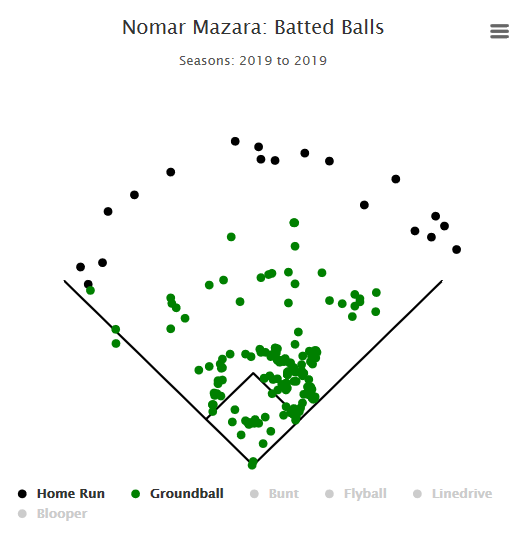

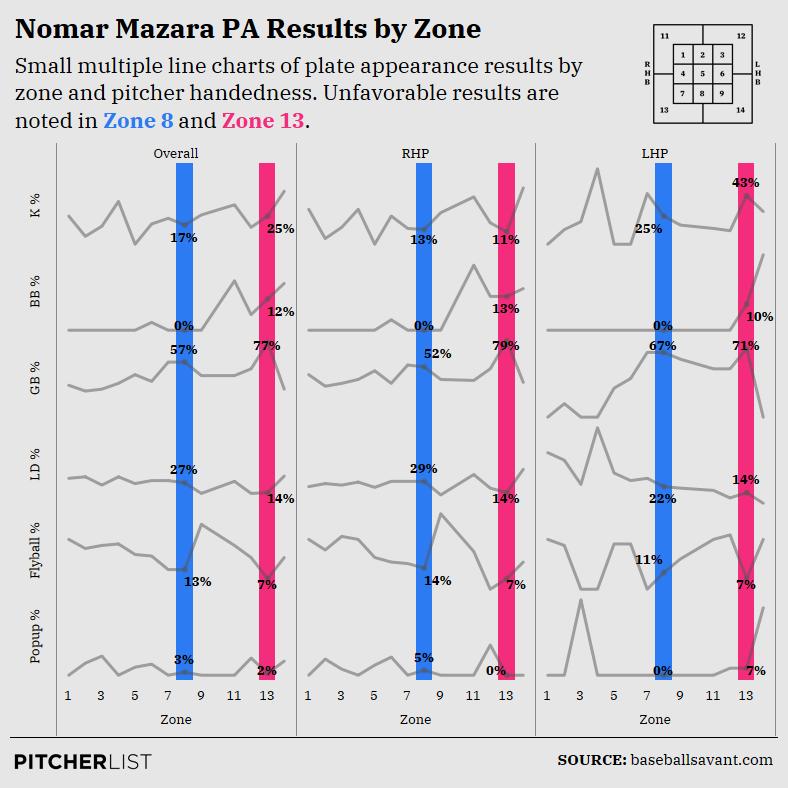
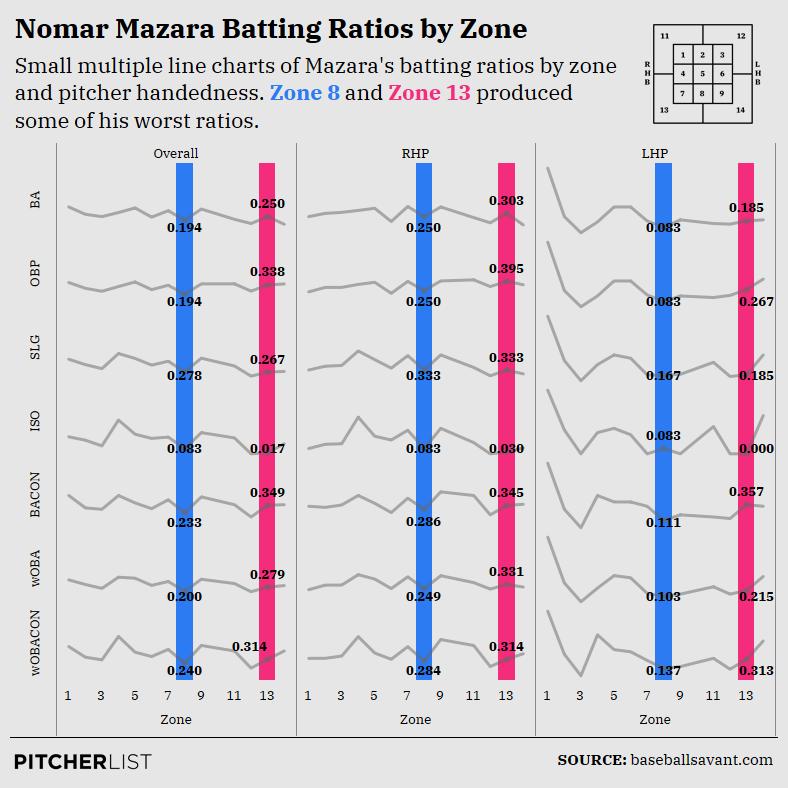
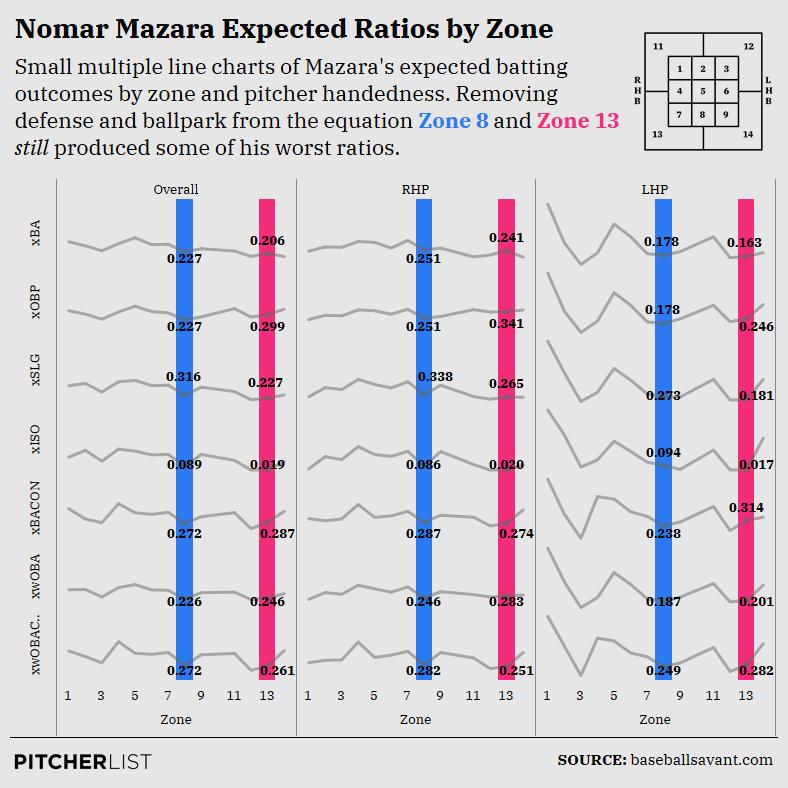
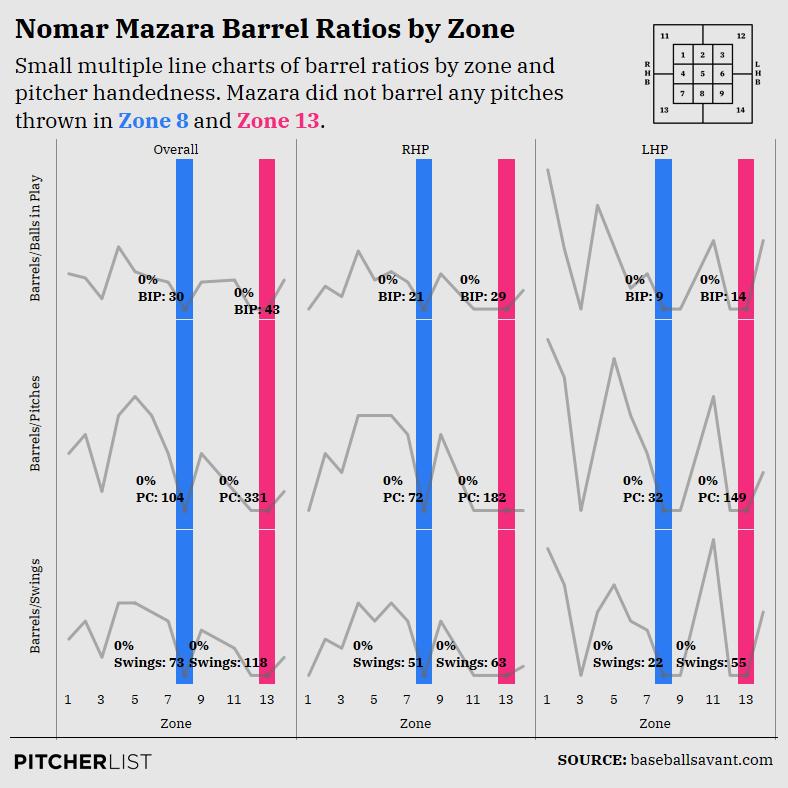



Fantastic and very thorough article – thank you!
Mark,
Good read, lots of detailed information. Two things I thought about when reading it:
1) You mentioned Mazara had an average launch angle of -4 degrees. In comparing him to Moncada and Anderson, what were their average launch angles? This could be a significant difference in their abilities to adjust (thinking Eric Hosmer).
2) The rate of Mazara’s O Swing is significant, but, as you touched on, the number of pitches he sees outside the strike zone is very high. How does that compare to Moncada’s and Anderson’s amount of outside pitches seen? Also, does he have a tendency to swing at stuff way outside the strike zone compared to Moncada and Anderson (maybe he chases on the outer edge of zone 13 at a high rate)? If so, this could indicate another issue (pitch recognition).
I hope he figures it out and reaches his potential.
Thanks
Dave,
Over the years I spent a lot of time looking at Hosmer’s swing and some of his prodigious HR’s. Bottom line is the guy refused to correct a large set-up hitch in his swing, which was his undoing. If you’ve ever read Charlie Lau’s Art of Hitting 300, you know every batter should have a “launch” position from which the swing starts. Lau was a firm believer that good hitters set up their swing efficiently, by getting their hands as close to that launch position as possible at set up. By doing so, you were ready to swing in a more timely fashion, when nano-seconds are the difference between crushing a ball and hitting a weak grounder. Hosmer’s problem was he had that huge timing waggle prior to getting to his launch position, which made it so that he hit an endless number of weak grounders due to missed timing.
THAT GUY KILLED ME: SO MUCH POTENTIAL wasted, due to pig-headedness or bad coaching.
Thanks for this! Hosmer might be one of those cases where we all know what’s wrong and never know why it never got fixed (there may still be time!). I’m hoping Mazara doesn’t follow the same path. The move to Chicago could be that fork in the road that will determine Mazara’s future production.
Thanks BBHHI
Thanks Dave! I just wanted to clarify a little. His average launch angle of -4 was in Zone 13 only. His average launch angle was much better in other zones (all other zones were positive), and his average LA in all zones was 10.5 degrees. So respectable. One of the things that I like about Mazara is that he has a new perspective in Chicago. He is out of the system that raised him, and after four seasons, should be ready for a new plan of attack. It appears that he was making progress in Texas before injuries hampered him and, by that point, the Rangers began transitioning him to a platoon. I see no reason why Mazara wouldn’t be able to adjust. If he doesn’t, we certainly have clearer insight into his fantasy viability.
To answer your second question: Moncada’s out of zone numbers are a little more murky because he is a switch hitter and requires a deeper investigation than the comments would provide. Anderson hits from the right side (Mazara hits from the left, obviously), so comparing those players Zone 13 results isn’t that helpful, but Anderson does struggle, as most players do, with pitches down and outside. It is tough to hit those pitches with any authority. The White Sox also loved to swing the bat in 2019, so pitchers would look for chases outside the zone.
I think that you are quite right to suggest that pitch recognition could be part of the issue. This is why I am so encouraged by new White Sox hitting coach Frank Menechino’s comments about improving the team’s approach at the plate. The White Sox as a team finished last in walks in 2019, and Menechino wants to change this. If he is successful, Mazara can really benefit. Pitchers will always throw pitches outside the zone if they can get away with it. They know the quality of contact is much weaker outside of the zone and opposing pitchers knew that White Sox hitters were going to be hacking. If Menechino can help all the Sox’s hitters to lay off those pitches, they will force pitchers into the zone and results should manifest. I’m hoping that they hired him because he has a tangible way to achieve this. Early in the season, we should monitor the White Sox walk rates. If they are rising, we might be able to deduce that Menechino’s approach is working.
Thanks Mark